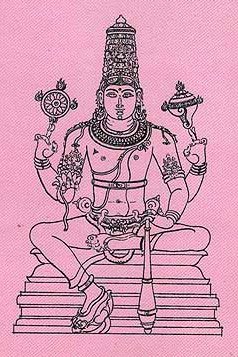Tanmaya: 13 definitions
Introduction:
Tanmaya means something in Buddhism, Pali, Hinduism, Sanskrit, Marathi, Hindi. If you want to know the exact meaning, history, etymology or English translation of this term then check out the descriptions on this page. Add your comment or reference to a book if you want to contribute to this summary article.
Alternative spellings of this word include Tanmay.
In Hinduism
Pancaratra (worship of Nārāyaṇa)
Source: eScholarship: Chapters 1-14 of the Hayasirsa PancaratraTanmaya (तन्मय) refers to an archaic designation of an ancient Bhakti cult.—At the time of their composition, many texts from the various sects who saw Viṣṇu as the highest god were not grouped under a common term, like Vaiṣṇava, as we are used to grouping them. Banerjea asserts that the Pādma Tantra says (in Banerjea’s translation): “Sūri, Suhṛt, Bhāgavata, Sātvata, Pañcakālavit, Ekāntika, Tanmaya and Pāñcarātrika are different designations of this Bhakti cult”. Banerjea also points out that the term Vaiṣṇava is absent.

Pancaratra (पाञ्चरात्र, pāñcarātra) represents a tradition of Hinduism where Narayana is revered and worshipped. Closeley related to Vaishnavism, the Pancaratra literature includes various Agamas and tantras incorporating many Vaishnava philosophies.
In Buddhism
Mahayana (major branch of Buddhism)
Source: academia.edu: A Study and Translation of the GaganagañjaparipṛcchāTanmaya (तन्मय) refers to “being attached (to something)” [?], according to the Gaganagañjaparipṛcchā: the eighth chapter of the Mahāsaṃnipāta (a collection of Mahāyāna Buddhist Sūtras).—Accordingly, “How then, son of good family, the Bodhisattva, having accumulated immeasurable merits, nourishes all living beings? Son of good family, (1) the Bodhisattva practices friendliness to all living beings; (2) he practices compassion to all creatures; (3) he is not attached to anything in particular (atanmaya-vihāritā) in his meditations; (4) he gives away all his possessions to beggars; (5) his pleasure is imperishable through his merits; (6) he is always committed to his intention by the purity of morality; [...]”.

Mahayana (महायान, mahāyāna) is a major branch of Buddhism focusing on the path of a Bodhisattva (spiritual aspirants/ enlightened beings). Extant literature is vast and primarely composed in the Sanskrit language. There are many sūtras of which some of the earliest are the various Prajñāpāramitā sūtras.
Languages of India and abroad
Marathi-English dictionary
Source: DDSA: The Molesworth Marathi and English Dictionarytanmaya (तन्मय).—a S (tad & maya Made up of that; being that itself.) Absorbed in; swallowed up or engrossed by; become one with. Ex. aikōni śāradēcēṃ gāyana || ta0 vidhi viṣṇu īśāna ||.
Source: DDSA: The Aryabhusan school dictionary, Marathi-Englishtanmaya (तन्मय).—a Absorbed in; become one with.
Marathi is an Indo-European language having over 70 million native speakers people in (predominantly) Maharashtra India. Marathi, like many other Indo-Aryan languages, evolved from early forms of Prakrit, which itself is a subset of Sanskrit, one of the most ancient languages of the world.
Sanskrit dictionary
Source: DDSA: The practical Sanskrit-English dictionaryTanmaya (तन्मय).—a. (-yī f.)
1) Made up of that.
2) Wholly absorbed in that; ज्वलति हृदयमन्तस्तन्मयत्वं च धत्ते (jvalati hṛdayamantastanmayatvaṃ ca dhatte) Māl. 1.41; Ś.6.21; M.2.9.
3) Identical with, or become one with that; ततस्तन्मयतां ययौ (tatastanmayatāṃ yayau) Rāj. T.3.498.
--- OR ---
Tanmaya (तन्मय).—See under तद् (tad).
Source: Cologne Digital Sanskrit Dictionaries: Benfey Sanskrit-English DictionaryTanmaya (तन्मय).—i. e. tad + maya, adj. Having the essence of him, her, it, that, Mahābhārata 3, 1143.
Source: Cologne Digital Sanskrit Dictionaries: Cappeller Sanskrit-English DictionaryTanmaya (तन्मय).—[adjective] consisting or made up of that; [abstract] tā [feminine], tva [neuter]
Source: Cologne Digital Sanskrit Dictionaries: Monier-Williams Sanskrit-English DictionaryTanmaya (तन्मय):—[=tan-maya] [from tan > tat] mfn. made up of that, absorbed in or identical with that, [Muṇḍaka-upaniṣad; Śvetāśvatara-upaniṣad; Pāraskara-gṛhya-sūtra; Mahābhārata] etc.
Source: DDSA: Paia-sadda-mahannavo; a comprehensive Prakrit Hindi dictionary (S)Tanmaya (तन्मय) in the Sanskrit language is related to the Prakrit word: Tammaya.
[Sanskrit to German]
Sanskrit, also spelled संस्कृतम् (saṃskṛtam), is an ancient language of India commonly seen as the grandmother of the Indo-European language family (even English!). Closely allied with Prakrit and Pali, Sanskrit is more exhaustive in both grammar and terms and has the most extensive collection of literature in the world, greatly surpassing its sister-languages Greek and Latin.
Hindi dictionary
Source: DDSA: A practical Hindi-English dictionaryTanmaya (तन्मय) [Also spelled tanmay]:—(a) identified (with); fully engrossed/absorbed (in); ~[tā] complete identification; trance.
...
Kannada-English dictionary
Source: Alar: Kannada-English corpusTanmaya (ತನ್ಮಯ):—[adjective] deeply interested or involved; wholly occupied; preoccupied; absorbed.
--- OR ---
Tanmaya (ತನ್ಮಯ):—[noun] a man engaged or involved (in something) with great interest.
Kannada is a Dravidian language (as opposed to the Indo-European language family) mainly spoken in the southwestern region of India.
See also (Relevant definitions)
Starts with: Tanmayama, Tanmayata, Tanmayate, Tanmayatva.
Ends with: Atanmaya, Etanmaya.
Full-text: Tanmayata, Tanmayibhava, Tanmayatva, Tammaya, Tanmay, Dhyanastha, Abhyantaratas, Pancaratrika, Pancakalavit, Suri, Bhagavata, Satvata, Ekantika, Suhrid.
Relevant text
Search found 15 books and stories containing Tanmaya, Tan-maya; (plurals include: Tanmayas, mayas). You can also click to the full overview containing English textual excerpts. Below are direct links for the most relevant articles:
Chaitanya Bhagavata (by Bhumipati Dāsa)
Verse 2.26.48 < [Chapter 26 - Descriptions of the Mercy Bestowed on Śuklāmbara and Vijay and the Lord’s Desire to Accept Sannyāsa]
Verse 1.16.204-208 < [Chapter 16 - The Glories of Śrī Haridāsa Ṭhākura]
Bhakti-rasamrta-sindhu (by Śrīla Rūpa Gosvāmī)
Verse 2.4.253 < [Part 4 - Transient Ecstatic Disturbances (vyābhicāri-bhāva)]
Mandukya Upanishad (Gaudapa Karika and Shankara Bhashya) (by Swami Nikhilananda)
Mandukya Karika, verse 4.39 < [Chapter IV - Alatashanti Prakarana (Quenching the firebrand)]
Brihad Bhagavatamrita (commentary) (by Śrī Śrīmad Bhaktivedānta Nārāyana Gosvāmī Mahārāja)
Verse 2.2.191 < [Chapter 2 - Jñāna (knowledge)]
Verse 1.5.29 < [Chapter 5 - Priya (the beloved devotees)]
Gitartha Samgraha (critical Study) (by Partha Sarathi Sil)
3. Other Books Mentioned in the Gītārthasaṅgraha < [Chapter 2 - Abhinavagupta and the Gītārthasaṅgraha]
Yoga Vasistha [English], Volume 1-4 (by Vihari-Lala Mitra)
Chapter XL - Brahma identic with the world or identity of the world with brahma < [Book IV - Sthiti prakarana (sthiti prakarana)]
Chapter LXXXVIII - A discourse on yoga meditation < [Book V - Upasama khanda (upashama khanda)]
Chapter CXLII - Ascertainment of karma or acts of men < [Book VII - Nirvana prakarana part 2 (nirvana prakarana)]